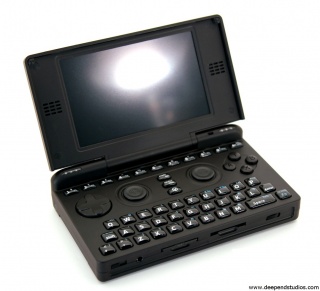User:WorldTripping
The Pandora is a combination of a seventh-generation handheld game console and miniature computer. It is the spiritual successor to other open handheld consoles such as the GP32 and GP2X. The device is open, meaning you can use it however you like and there are no restrictions or fees placed on developers, so anyone can write and release software for it. It runs a custom distribution of Linux based on Ångström and is currently the most powerful handheld gaming console available.
Conky is a system monitor for the X Window System. It is available for the Pandora from the Angstrom repository. Conky is highly configurable Expert's guide to configuring Conky by Dmitri PopovConky: highly configurable system monitor for X by Casey Stamper on Debian.net</ref><ref name="Wieseler">GKrellM vs. Conky by Sebastian Wieseler</ref> and is able to monitor many system variables including the status of the CPU, memory, swap space, disk storage, temperatures, processes, network interfaces, battery power, system messages, e-mail inboxes, Arch Linux updates, many popular music players (MPD, XMMS2, BMPx, Audacious), and much more.<ref name="docs">Conky documentation</ref> Unlike system monitors that use high-level widget toolkits to render their information, Conky is drawn directly in an X window. This allows it to consume relatively fewer system resources when configured similarly.<ref name="mulander">conky review by mulander</ref><ref name="Sharma">CLI Magic: Lightweight Conky is a system monitor powerhouse by Shashank Sharma on Linux.com</ref>
Conky has gained a strong following among many Linux and BSD enthusiasts, and was hailed as "one of the best maintained, and definitely one of the most useful, programs in the world of open source" according to Jan Rähm in a March 2009 article in Linux Magazine.
Contents
History
Conky is a fork of torsmo, a system monitor that is no longer maintained. Torsmo, however, continues to be used in systems where applications that use minimal resources are preferred. Damn Small Linux, for example, runs torsmo in its desktop root window on the default installation of its Live CD.
Common uses
While Conky is ideally suited for use as a system monitor, it can also be used to gather and display almost any type of information on the user's desktop (as well as in the command line, if one chooses). Conky can be extended with the Lua programming language, and uses its own functional-ish configuration file syntax. Conky features built-in support for several unrelated sources of information, but its biggest strength lies in its ability to be extended through scripting.
Conky has also been ported to devices such as the Nokia N900<ref name="n900">Nokia N900 Conky package</ref>, and can be ported to practically any system with GCC and an X11 implementation.
Users have created and distributed many customized scripts, demonstrating Conky's modularity and versatility in function and appearance. A thread on the Ubuntu forums has grown to over 1300 pages of users sharing their configurations.<ref name="rc_screens">Post your .conkyrc files w/ screenshots</ref><ref name="scripts">Conky scripts</ref><ref name="gmail">Conky Gmail Revisited</ref><ref name="howto">Howto: Get a beautiful Conky 1.4.2 setup</ref>
Usage example
A simple configuration for Conky which displays the time on a user's desktop is as follows:
update_interval 30
own_window yes
own_window_type desktop
use_xft yes
xftfont DejaVu Sans:size=14
alignment bottom_right
TEXT
${time %H:%M}
Default configuration file location is $HOME/.conkyrc or ${sysconfdir}/conky/conky.conf. On most systems, sysconfdir is /etc, and you can find the sample config file there (/etc/conky/conky.conf).<ref name="docs" />
Screenshots
- Arch Linux.png
Conky on Arch Linux
- Conkyonubuntu.png
Conky on Ubuntu
- Conkyubuntu.png
Conky on Lucid Lynx
See also
References
<references/>
